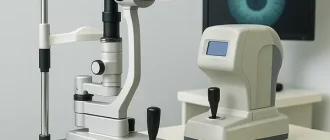The feeling that your eyes are crossing or struggling to align is not uncommon and can be quite disorienting. This issue, known medically as binocular vision dysfunction, can lead to headaches, blurred vision, double vision, or even dizziness. It’s important to understand the underlying causes and the potential solutions available. This article aims to explore the reasons behind this condition, share insights from recent medical trends, and provide guidance on managing and alleviating symptoms.
What Causes Misalignment of the Eyes?
Eye misalignment can occur for several reasons, ranging from muscle imbalances to neurological issues. Below are some of the key causes:
| Cause | Description |
|---|---|
| Strabismus | Misalignment of the eyes due to muscle imbalance. |
| Convergence Insufficiency | Difficulty aligning eyes when focusing on close objects. |
| Nerve Problems | Issues with cranial nerves that control eye movement. |
| Trauma or Injury | Head trauma affecting the eye muscles or nerves. |
| Eye Fatigue | Extended screen time leading to muscle strain. |
Strabismus: A Leading Cause
Strabismus, often referred to as “crossed eyes,” is a common condition where the eyes do not align properly. This misalignment occurs because the six muscles that control eye movement fail to work together as they should. Strabismus can affect both children and adults, with approximately 4% of the U.S. population experiencing some form of the condition. Early intervention is key to minimizing long-term vision problems, and treatment often includes corrective glasses, vision therapy, or surgery.
The cost of corrective surgery for strabismus can range from $5,000 to $10,000, depending on the severity and location of treatment. However, many cases can be managed without surgery through less invasive measures.
Convergence Insufficiency: Struggling with Close Focus
Another common reason for the sensation of eyes struggling to align is convergence insufficiency (CI). This condition affects the ability of both eyes to work together when focusing on a nearby object. CI often presents itself during reading or using a computer, leading to symptoms like headaches, blurry vision, and eye strain. According to recent studies, CI affects roughly 5-10% of the population and is most prevalent among children and young adults.
Treatment for convergence insufficiency typically involves vision therapy exercises designed to strengthen the eye muscles and improve focus. Vision therapy may include in-office sessions combined with at-home exercises, and the cost can range between $500 and $2,000 for a typical treatment program.
How Prolonged Screen Time Affects Eye Alignment
In today’s digital age, prolonged screen time has become a significant contributor to eye alignment issues. Staring at screens for extended periods can cause eye muscles to become fatigued, leading to symptoms like temporary double vision or the sensation that your eyes are crossing. This phenomenon, often called computer vision syndrome (CVS), affects more than 60% of adults who use computers or digital devices for more than six hours a day.
To combat eye strain, the 20-20-20 rule is often recommended: every 20 minutes, take a 20-second break and look at something 20 feet away. This simple habit can significantly reduce eye fatigue and help maintain proper eye alignment.
| Screen Time Effect | Symptom |
|---|---|
| Prolonged Usage | Eye fatigue and difficulty focusing |
| Poor Ergonomics | Headaches, neck strain, and eye misalignment |
| Lack of Breaks | Increased likelihood of convergence issues |
Diagnosing Eye Alignment Issues
Diagnosing issues with eye alignment requires a thorough examination by an optometrist or ophthalmologist. Eye alignment problems are often detected using special tests such as:
- Cover Test: Used to measure how the eyes work together by covering and uncovering each eye while focusing on an object.
- Prism Lens Test: Measures the degree of misalignment and helps determine the correct prescription or therapy.
- Ocular Motility Exam: Evaluates the function of the six muscles that control eye movement.
Prevalence of Eye Misalignment Conditions by Age Group
Modern Trends in Treatment: Vision Therapy and Prism Glasses
One of the growing trends in treating eye alignment issues is vision therapy, a personalized, non-surgical approach aimed at improving the coordination of the eyes. Vision therapy typically consists of guided exercises to strengthen eye muscles and enhance focus. It is particularly effective for conditions like convergence insufficiency and accommodative dysfunction.
Another option for those struggling with misalignment is the use of prism glasses. These specialized lenses can help reduce double vision by bending light before it enters the eye, aiding in proper alignment. The cost of prism glasses ranges from $300 to $800, depending on the level of correction needed.
Practical Example: Managing Eye Alignment Issues
Consider the case of a 32-year-old graphic designer who experienced symptoms of eye misalignment, particularly after long periods of computer use. The individual was diagnosed with convergence insufficiency and prescribed vision therapy exercises, which were done both in-office and at home over a span of 10 weeks. The results showed a significant reduction in symptoms, allowing the designer to work comfortably without experiencing fatigue or double vision.
Advice from Our Editorial Team
If you often feel like your eyes are crossing or struggling to align, don’t ignore these symptoms. Prolonged misalignment can lead to chronic headaches, vision problems, and a reduced quality of life. Start by reducing screen time or following the 20-20-20 rule to minimize eye strain. Consulting an eye specialist for an accurate diagnosis and exploring options like vision therapy or prism glasses can also help address the root of the problem. Taking proactive steps can help maintain both the health of your eyes and your overall well-being.





